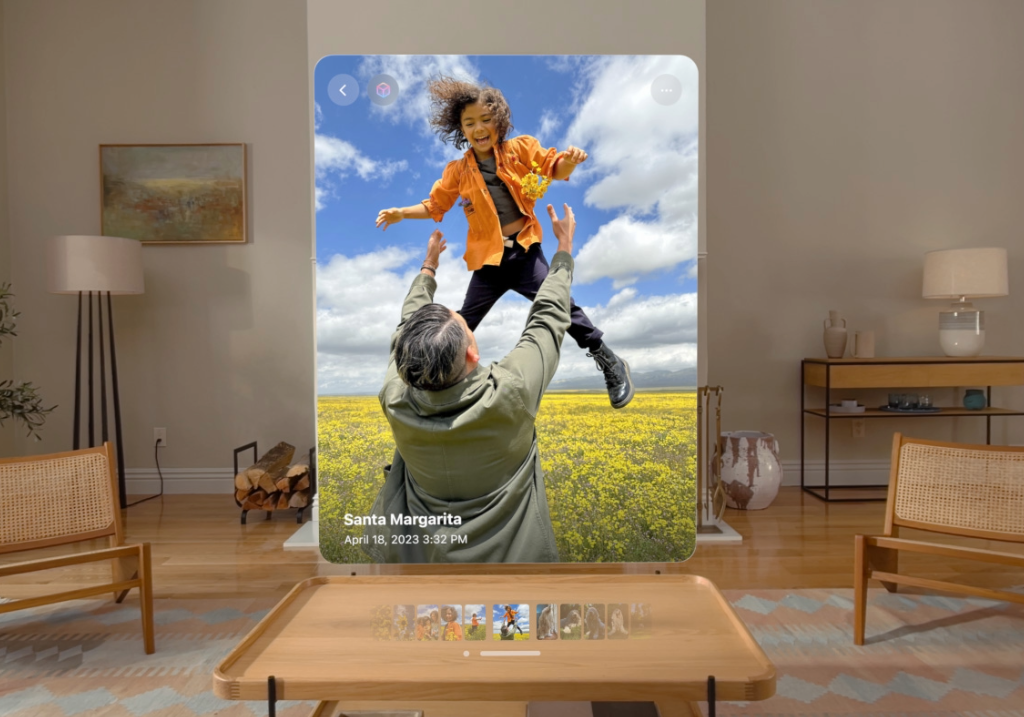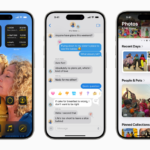Apple’s recent preview of visionOS 2, the upcoming major update for its spatial operating system powering the Vision Pro headset, has sent ripples of excitement through the tech world. This comprehensive update promises to redefine the spatial computing landscape with an array of innovative features and enhancements.
Unveiled at WWDC 2024, visionOS 2 redefines spatial computing on Apple Vision Pro. Moreover, new features like Optic ID and enhanced FaceTime promise to revolutionize interactions. Consequently, Apple solidifies its position at the forefront of this emerging technology.
Optic ID: A New Era of Secure Authentication
One of the most noteworthy additions is Optic ID, a groundbreaking security feature that leverages iris scanning for authentication. This cutting-edge technology ensures a seamless and secure way for users to unlock their Vision Pro headsets and access sensitive information. Optic ID could potentially revolutionize how we approach authentication, offering a higher level of security than traditional methods like passwords or fingerprints.
Read more: Apple Vision Pro Makes Its International Debut, Landing in China, Hong Kong, Japan, and Singapore
FaceTime Reimagined: Deeper Connections in a Spatial Realm
visionOS 2 takes FaceTime to new heights by introducing enhancements that transform virtual interactions. Improved spatial audio provides a more immersive experience, making it feel as if participants are physically present in the same space. The addition of 3D persona representations adds another layer of realism, allowing users to connect with each other in a more personal and engaging way. These advancements could reshape how we communicate and collaborate remotely, fostering deeper connections despite physical distances.
Photos App: Memories Come Alive in 3D
The updated Photos app in visionOS 2 enables users to view their cherished photos and videos in a whole new dimension – 3D. This immersive experience brings memories to life, allowing users to relive moments with a sense of depth and realism that traditional 2D viewing cannot match. The ability to share photos and videos in 3D with others enhances the social aspect of reliving memories, making it a more interactive and engaging experience.
New Ways to Capture Memories: Spatial Photos and Videos
visionOS 2 empowers users to capture spatial photos and videos using their Vision Pro headsets. This feature opens up exciting possibilities for creative expression and documentation. Users can now record their experiences in a way that captures the depth and spatial relationships of the real world. Imagine being able to revisit a concert or a family gathering as if you were there, with all the spatial details preserved.
Enhanced Accessibility: Empowering Users of All Abilities
Apple has consistently demonstrated a commitment to accessibility, and visionOS 2 is no exception. The update introduces enhanced eye tracking and voice control features, making the Vision Pro headset more accessible to users with disabilities. These improvements enable individuals with limited mobility or visual impairments to interact with the device more effectively, ensuring that everyone can benefit from the immersive experiences it offers.
Expanded App Ecosystem: A World of Possibilities
With visionOS 2, Apple is opening the doors to a broader range of third-party apps designed specifically for the Vision Pro headset. This move signifies a growing interest in spatial computing among developers and promises to enrich the user experience with a diverse selection of applications. We can expect to see innovative tools, games, and experiences that leverage the unique capabilities of the Vision Pro platform.
Developer Tools: Building the Future of Spatial Computing
Apple’s commitment to fostering a thriving developer community is evident in the updated SDK and tools included in visionOS 2. These resources empower developers to create immersive apps that push the boundaries of what’s possible in spatial computing. As developers explore the potential of visionOS 2, we can anticipate a wave of groundbreaking applications that redefine how we interact with digital content.
The Road Ahead
visionOS 2 is poised to solidify Apple’s position at the forefront of spatial computing. By introducing innovative features, enhancing accessibility, and expanding the app ecosystem, Apple is creating a platform that has the potential to revolutionize how we work, play, and connect with the world around us. While the Vision Pro headset is currently a niche product, the advancements in visionOS 2 could pave the way for wider adoption of spatial computing in the future.
As developers and users alike delve into the possibilities of visionOS 2, the full extent of its impact remains to be seen. However, one thing is clear: Apple’s vision for the future of spatial computing is ambitious and promising.
visionOS 2 FAQs
A. visionOS 2 is the upcoming major update to Apple’s spatial operating system, designed specifically for the Vision Pro headset. It introduces a range of new features and enhancements that promise to redefine the spatial computing experience.
A. Optic ID: A secure authentication method using iris scanning.
Enhanced FaceTime: Improved spatial audio and 3D persona representations for more immersive calls.
3D Photos and Videos: View and share photos and videos in 3D.
Spatial Media Capture: Capture spatial photos and videos with the Vision Pro headset.
Enhanced Accessibility: Improved eye tracking and voice control features.
Expanded App Ecosystem: More third-party apps coming to visionOS.
Updated Developer Tools: New SDK and tools for creating immersive apps for Vision Pro.
A. Optic ID uses the unique patterns in your iris to securely authenticate you and unlock your Vision Pro headset. It’s a more secure and convenient alternative to traditional methods like passwords or fingerprints.
A. The improved spatial audio and 3D persona representations in FaceTime create a more immersive and realistic experience, making it feel as if you’re physically present with the person you’re talking to.
A. You can view your spatial photos and videos in 3D, reliving your memories with a new sense of depth and realism. You can also share them with others, allowing them to experience your memories as if they were there.
A. visionOS 2 introduces enhanced eye tracking and voice control features, making the Vision Pro headset more accessible to users with disabilities. This allows them to interact with the device more effectively and enjoy its immersive experiences.
A. Apple has not yet announced an official release date for visionOS 2, but it is expected to be available sometime in 2024.
A. No, visionOS 2 will be a free update for all existing Vision Pro headset owners.
A. visionOS 2 represents a significant step forward for spatial computing. Its innovative features, expanded app ecosystem, and enhanced accessibility have the potential to revolutionize how we work, play, and connect with the world around us.



